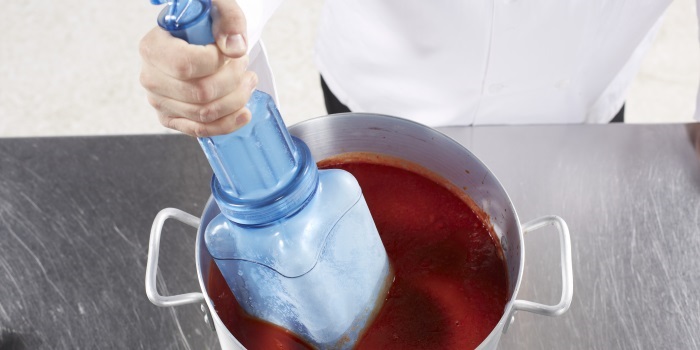National Food Safety Month Week 4: Follow safe food procedures
 Cool hot foods properly before storing them, from 135°F to 70°F within two hours, and from 70°F to 41°F or lower within the next four. Tools such as ice paddles help speed the cooling process.
Cool hot foods properly before storing them, from 135°F to 70°F within two hours, and from 70°F to 41°F or lower within the next four. Tools such as ice paddles help speed the cooling process.When TCS food — food that must be time- and temperature-controlled for safety — remains in temperatures between 41°F and 135°F, it’s at risk for causing foodborne illness. This range is called the danger zone because pathogens thrive in those temperatures.
The longer food stays in the temperature danger zone, the more time pathogens have to grow. To keep food safe, you must keep it out of the temperature danger zone or limit the time it spends in this range.
Here are six tips to help make that happen:
1. Receive food correctly.
If food isn’t safe when you receive it, there’s nothing you can do to make it safe afterward.
- Purchase food from approved, reputable suppliers only. Those suppliers have been inspected and can show you inspection reports. They comply with local, state, and federal laws.
- Receive food at the right temperature. Receive cold TCS food at 41°F or lower unless otherwise specified. Receive hot TCS food at 135°F or higher.
- Frozen food should be frozen solid when received.
Train employees to check temperatures when food is delivered to ensure it’s within safe ranges. Look for signs of thawing/refreezing, and empower employees to decline supplies that are out of the right temperature range or seem questionable.
To extend your Food Safety Month experience, visit our resources page to download posters, activity sheets, and more!
2. Store food correctly.
If food is not stored at the correct temperature, any pathogens in the food can grow to unsafe levels and cause foodborne illness.
- Store food at the correct temperature. Store TCS food at an internal temperature of 41°F or lower or 135°F or higher.
- Store frozen food at temperatures that will keep it frozen.
- Monitor food temperatures regularly.
- Date-mark TCS food that are held longer than 24 hours. Refrigeration slows the growth of most bacteria, but some types will grow well at refrigeration temperatures. Ready-to-eat TCS food stored at 41°F or lower can only be stored for a maximum of seven days. After this time some types of bacteria can grow to dangerous levels
3. Cook food to the right temperature.
To reduce pathogens in food to safe levels you need to cook it to its required minimum internal temperature. Once the temperature is reached, you must hold the food at that temperature for a specific amount of time.
Different foods need to be cooked to different temperatures:
165°F for <1 second (Instantaneous):
- Poultry, including whole or ground chicken, turkey or duck
- Stuffing made with fish, meat, or poultry
- Stuffed meat, seafood, poultry, or pasta
- Dishes that include previously cooked TCS ingredients
155°F for 17 seconds:
- Ground meat including beef, pork and other meat
- Meat mechanically tenderized with needles or blades or by injecting it with brine or flavors (e.g., brined ham or flavor-injected roasts)
- Meat vacuum-tumbled with marinades or other solutions
- Ground meat from game animals commercially raised and inspected
- Ratites (mostly flightless birds with flat breastbones), including ostrich and emu
- Ground seafood including chopped or minced seafood
- Shell eggs that will be held hot for service
145°F for 15 seconds:
- Seafood including fish, shellfish and crustaceans
- Steaks/chops of pork, beef, veal and lamb
- Commercially raised game
- Shell eggs that will be served immediately
135°F (no minimum time):
- Food from plants, including fruits, vegetables, grains (e.g., rice, pasta), and legumes (e.g., beans, refried beans) that will be held hot for service
4. Hold food at the right temperature.
Keep hot food hot and cold food cold to prevent bacteria from growing to unsafe levels.
- Hold cold TCS food at 41°F or lower
- Hold hot TCS food at 135°F or higher
5. Cool food as quickly as possible.
Pathogens grow well at temperatures between 41°F and 135°F, but they will grow much faster between 125°F and 70°F. Food needs to pass through this temperature range quickly to reduce pathogen growth.
Never cool food at room temperature; instead, cool food from 135°F to 41°F or lower within six hours, as follows:
- First, cool food from 135°F to 70°F within two hours.
- Then cool it from 70°F to 41°F or lower within the next four hours.
- Never cool large amounts of TCS food in a cooler.
- Divide hot food into smaller containers/amounts before cooling.
6. Reheat food the right way.
If food is not handled carefully during holding or cooling, any pathogens in the food can multiply to dangerous levels. Reheating food properly can reduce these pathogens to safe levels:
- Food that will be served immediately can be reheated to any temperature.
- TCS food that will be reheated for hot holding must be reheated to 165°F for 15 seconds within two hours.